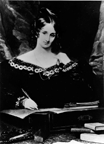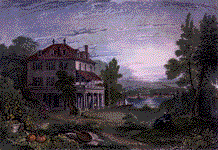The Birth of Frankenstein
Hollywood did not give birth to Frankenstein; Mary Shelley did.
More than a century before actor Boris Karloff, helped by make-up artists,
made the monster in his image, came Shelley and her creation.
The mother of Frankenstein came from the rarefied reaches of
the British artistic and intellectual elite. While Mary Shelley drew her
inspiration from a dream, she drew her story's premises about the nature
of life from the work of some of Europe's premier scientists and thinkers.
The sophisticated creature that billowed up from her imagination read Plutarch
and Goethe, spoke eloquently, and suffered much.

Mary Shelley
Corbis-Bettmann

A Dark and Stormy Night
In the summer of 1816, nineteen-year-old Mary Wollstonecraft Godwin and
her lover, the poet Percy Shelley (whom she married later that year), visited
the poet Lord Byron at his villa beside Lake Geneva in Switzerland. Stormy
weather frequently forced them indoors, where they and Byron's other guests
sometimes read from a volume of ghost stories. One evening, Byron challenged
his guests to each write one themselves. Mary's story, inspired by a dream,
became Frankenstein.

The Villa Diodati
The Granger Collection,
New York |
When I placed my head upon my pillow, I did
not sleep, nor could I be said to think. . . . I saw--with shut eyes, but
acute mental vision--I saw the pale student of unhallowed arts kneeling
beside the thing he had put together. I saw the hideous phantasm of a man
stretched out, and then, on the working of some powerful engine, show signs
of life, and stir with an uneasy, half-vital motion. Frightful must it
be; for supremely frightful would be the effect of any human endeavor to
mock the stupendous Creator of the world.
Mary Shelley, from her introduction to the third edition of
Frankenstein |

A Writer's Life
Mary Shelley came from a rich literary heritage. She was the daughter of
William Godwin, a political theorist, novelist, and publisher who introduced
her to eminent intellectuals and encouraged her youthful efforts as a writer;
and of Mary Wollstonecraft, a writer and early feminist thinker, who died
shortly after her daughter's birth.
At fifteen, Mary met the poet Percy Shelley, who was married at the
time. Two years later, she ran off with him to France. They were married
in December 1816, two weeks after Percy Shelley's first wife drowned. By
then Mary had already borne him two children.
Boundary Crossings in 1818
In her novel, Mary Shelley is silent on just how Victor Frankenstein breathes
life into his creation, saying only that success crowned "days and nights
of incredible labor and fatigue;" Frankenstein offers no monster-making
recipes.
But Shelley's story did not arise from the void. Scientists and physicians
of her time, tantalized by the elusive boundary between life and death,
probed it through experiments with lower organisms, human anatomical studies,
attempts to resuscitate drowning victims, and experiments using electricity
to restore life to the recently dead.
A Physical Dissertation on Drowning, 1747
Rowland Jackson (d. ca. 1787)
National Library of Medicine Collection
When Percy Shelley's first wife, Harriet, drowned in London in 1816,
rescuers took her lifeless body to a receiving station of the London Society.
There, smelling salts, vigorous shaking, electricity, and artificial respiration--as
with the resuscitation bellows shown here--had been used since the 1760s
to restore drowning victims to life. Harriet, however, did not survive.

Restored to Life?
In March 1815, Mary Shelley dreamed of her dead infant daughter held before
a fire, rubbed vigorously, and restored to life. At the time, scientists
would not have wholly dismissed such a possibility. Could the dead be brought
back to life? Could life arise spontaneously from inorganic matter? Physicians
of the day treated such questions seriously--as the treatises they wrote,
the methods they employed, and the contrivances they built all testify.
Blundell's Gravitator
Pennsylvania State University Libraries
James Blundell, a London physician troubled by the many women who died
after childbirth from massive bleeding, introduced blood transfusion between
humans, using the simple apparatus shown here. Reproduction of an illustration
from The Lancet, 1828-1829.

Galvanism
During the 1790s, Italian physician Luigi Galvani demonstrated what we
now understand to be the electrical basis of nerve impulses when he made
frog muscles twitch by jolting them with a spark from an electrostatic
machine. When Frankenstein was published, however, the word galvanism
implied the release, through electricity, of mysterious life forces. "Perhaps,"
Mary Shelley recalled of her talks with Lord Byron and Percy Shelley, "a
corpse would be reanimated; galvanism had given token of such things."
Galvani's Experiments
National Library of Medicine Collection
Illustration of Italian physician Luigi Galvani's experiments, in which
he applied electricity to frogs legs; from his book De Viribus Electricitatis
in Motu Musculari (1792).
A Galvanized Corpse
Library of Congress, Prints & Photographs Division
Electricity's seeming ability to stir the dead to life gave the word
galvanize its own special flavoring, as this 1836 political cartoon of
a "galvanized" corpse suggests.

Body Parts
To make his creature, Victor Frankenstein "dabbled among the unhallowed
damps of the grave" and frequented dissecting rooms and slaughterhouses.
In Mary Shelley's day, as in our own, the healthy human form delighted
and intrigued artists, physicians, and anatomists. But corpses, decaying
tissue, and body parts stirred almost universal disgust. Alive or dead,
whole or in pieces, human bodies arouse strong emotion--and account for
part of Frankenstein's enduring hold on us.
De Monstro Nato Lutetiae Anno Domini, 1605
National Library of Medicine Collection
As this early book illustration suggests, nature's own "monsters"--sharp
deviations from normal human development--fascinated anatomists of Mary
Shelley's day and before.

History of Medicine Home
Page
U.S. National Library
of Medicine (NLM) http://www.nlm.nih.gov/
Last updated: 28 January 1998
hmdweb@nlm.nih.gov

HOME | INDEX

Academic year 1999/2000
Narrativa en lengua inglesa
I 1999-2000
(c) a.r.e.a. Dr. Vicente Forés
López
(c) Teresa M. Pujol Salvador
Universitat de València
Press
Page maintained by Teresa Pujol
Salvador
© Copyright 1999/2000 Teresa
Pujol Salvador








